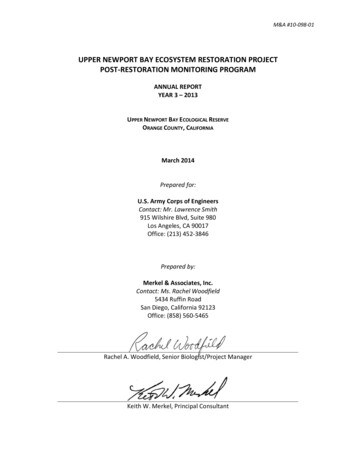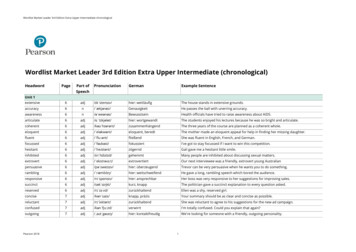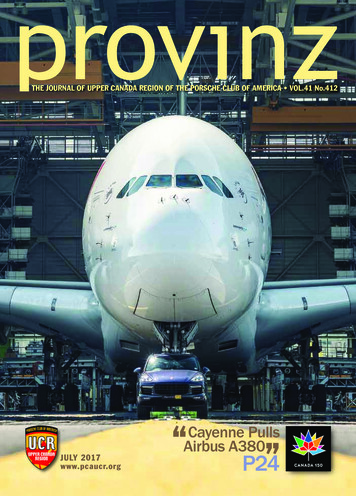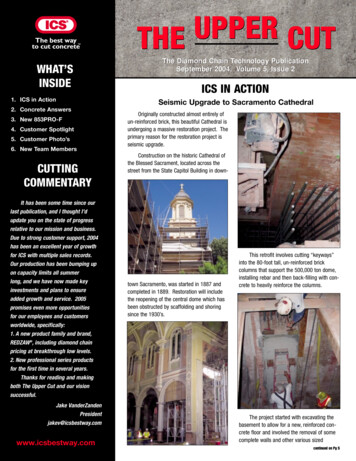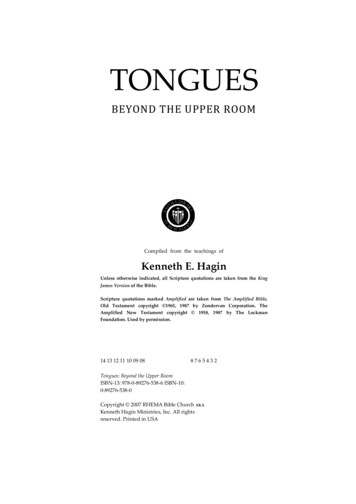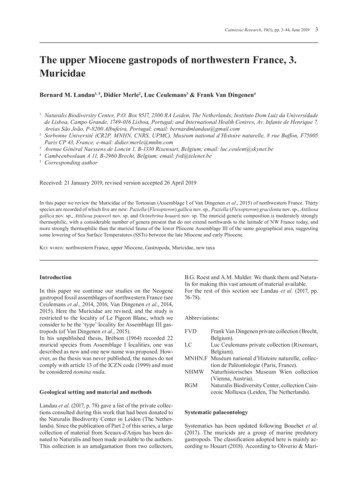
Transcription
Cainozoic Research, 19(1), pp. 3-44, June 20193The upper Miocene gastropods of northwestern France, 3.MuricidaeBernard M. Landau1, 5, Didier Merle2, Luc Ceulemans3 & Frank Van Dingenen412345Naturalis Biodiversity Center, P.O. Box 9517, 2300 RA Leiden, The Netherlands; Instituto Dom Luiz da Universidadede Lisboa, Campo Grande, 1749-016 Lisboa, Portugal; and International Health Centres, Av. Infante de Henrique 7,Areias São João, P-8200 Albufeira, Portugal; email: bernardmlandau@gmail.comSorbonne Université (CR2P, MNHN, CNRS, UPMC), Muséum national d’Histoire naturelle, 8 rue Buffon, F75005Paris CP 43, France; e-mail: didier.merle@mnhn.comAvenue Général Naessens de Loncin 1, B-1330 Rixensart, Belgium; email: luc.ceulem@skynet.beCambeenboslaan A 11, B-2960 Brecht, Belgium; email: fvd@telenet.beCorresponding authorReceived: 21 January 2019, revised version accepted 26 April 2019In this paper we review the Muricidae of the Tortonian (Assemblage I of Van Dingenen et al., 2015) of northwestern France. Thirtyspecies are recorded of which five are new: Paziella (Flexopteron) gallica nov. sp., Paziella (Flexopteron) gracilenta nov. sp., Attiliosagallica nov. sp., Attiliosa pouweri nov. sp. and Ocinebrina houarti nov. sp. The muricid generic composition is moderately stronglythermophilic, with a considerable number of genera present that do not extend northwards to the latitude of NW France today, andmore strongly thermophilic than the muricid fauna of the lower Pliocene Assemblage III of the same geographical area, suggestingsome lowering of Sea Surface Temperatures (SSTs) between the late Miocene and early Pliocene.Key words: northwestern France, upper Miocene, Gastropoda, Muricidae, new taxaIntroductionIn this paper we continue our studies on the Neogenegastropod fossil assemblages of northwestern France (seeCeulemans et al., 2014, 2016; Van Dingenen et al., 2014,2015). Here the Muricidae are revised, and the study isrestricted to the locality of Le Pigeon Blanc, which weconsider to be the ‘type’ locality for Assemblage III gastropods (of Van Dingenen et al., 2015).In his unpublished thesis, Brébion (1964) recorded 22muricid species from Assemblage I localities, one wasdescribed as new and one new name was proposed. However, as the thesis was never published, the names do notcomply with article 13 of the ICZN code (1999) and mustbe considered nomina nuda.Geological setting and material and methodsLandau et al. (2017, p. 78) gave a list of the private collections consulted during this work that had been donated tothe Naturalis Biodiverity Center in Leiden (The Netherlands). Since the publication of Part 2 of this series, a largecollection of material from Sceaux-d’Anjou has been donated to Naturalis and been made available to the authors.This collection is an amalgamation from two collectors,B.G. Roest and A.M. Mulder. We thank them and Naturalis for making this vast amount of material available.For the rest of this section see Landau et al. (2017, pp.76-78).Abbreviations:FVDFrank Van Dingenen private collection ( Brecht,Belgium).LCLuc Ceulemans private collection (Rixensart,Belgium).MNHN.F Muséum national d’Histoire naturelle, collection de Paléontologie (Paris, France).NHMW Naturhistorisches Museum Wien collection(Vienna, Austria).RGMNaturalis Biodiversity Center, collection Cainozoic Mollusca (Leiden, The Netherlands).Systematic palaeontologySystematics has been updated following Bouchet et al.(2017). The muricids are a group of marine predatorygastropods. The classification adopted here is mainly according to Houart (2018). According to Oliverio & Mari-
4Landau, Merle, Ceulemans & Van Dingenen. The upper Miocene gastropods of northwestern France, 3. Muricidaeottini (2001) and Barco et al. (2010), the Coralliophilinaeare also arranged within the Muricidae.The descriptions adopt the terminology suggested byMerle (1999, 2001, 2005), see below:PstAdAbSPIPprimary cordsecondary cordtertiary cordadapical (or abapertural)abapical (or adapertural)subsutural cordinfrasutural primary cord (primary cord onshoulder)adisadapical infrasutural secondary cord (shoulder)abisabapical infrasutural secondary cord (shoulder)P1shoulder cordP2-P6 primary cords of the convex part of the teleoconch whorls1-s6 secondary cords of the convex part of the teleoconch whorlexample: s1 secondary cord between P1 andP2; s2 secondary cord between P2 and P3, etc.ADP adapertural primary cord on the siphonal canalMPmedian primary cord on the siphonal canalABP abapertural primary cord on the siphonal canaladsadapertural secondary cord on the siphonal canalmsmedian secondary cord on the siphonal canalabsabapertural secondary cord on the siphonal canalAperture:IDinfrasutural denticleD1-D6 abapical denticlesCorrections to Assemblage III Part 3 Ceulemans et al.(2016)p. 46: Plate 3, figures 8 and 9 have been reversed. Figure8 is Hirtomurex aff. squamosus (Bivona Ant. in BivonaAnd., 1838), figure 9 is Coralliophila cf. burdigalensis(Tournouër, 1874).Litorinella are nomina nuda.p. 298: Hydrobia tournoueri Sandberger, ‘1875’. The correct date of publication is 1872, when plate 26 with thespecies-group name in the legend was published.p. 301: Potamiopsidae and Potamiopsinae should spellPomatiopsidae and Pomatiopsinae Stimpson, 1865.My thanks to Dietrich Kadolsky for pointing out theseerrors.Superfamily Muricoidea Rafinesque, 1815Family Muricidae Rafinesque, 1815Subfamily Muricinae Rafinesque, 1815Genus Bolinus Pusch, 1837Type species (by original designation) – Murex brandarisLinnaeus, 1758, present-day, Atlantic and MediterraneanSea.183718531917Bolinus brandaris torularius (Lamarck, 1822)Plate 1, figs 1-3*182219581964Corrections to Assemblage I Part 2 Landau et al. (2018)2007p. 298: Leachia Risso, 1826 is a junior homonym of Leachia Lesueur, 1821. The originally included species Leachiaviridescens Risso, 1826 is not Hydrobia acuta (Draparnaud 1805) and is best regarded as a nomen dubium orspecies inquirenda. Bythinella Moquin-Tandon 1856 is areplacement name for Leachia Risso. Its type species wasfixed by the ICZN (2006, Opinion 2161) as Bulimus viridisPoiret, 1801. As both original and replacement name haveto have the same type species, the type species of LeachiaRisso, 1826 is Bulimus viridis Poiret, 1801.2011p. 298: Litorinella Braun, 1843. The type species is Cyclostoma acutum Draparnaud, 1805 by monotypy. Allother species-group names attributed by Braun (1843) toBolinus Putsch, p. 134.Rhinocantha H. & A. Adams, p. 72. Type species(by subsequent designation, Vokes, 1964): Murexbrandaris Linnaeus, 1758, present-day, Atlanticand Mediterranean Sea. Junior objective synonymof Bolinus Pusch, 1837.Brandaria Monterosato, p. 20. Type species (byoriginal designation): Murex brandaris Linnaeus,1758, present-day, Atlantic and MediterraneanSea. Junior objective synonym of Bolinus Pusch,1837.2011201320132013Murex torularius Lamarck, p. 576.Murex (Murex) torularius Lamarck – Erünal-Erentöz, p. 53, pl. 8, figs 1, 2.Murex torularius Lamarck, 1822 – Brébion, p.370, pl. 9, figs 1, 2.Bolinus brandaris torularius (Lamarck, 1822) –Landau et al., p. 5, pl. 1, figs 3-6 (cum syn.).Bolinus brandaris torularius (Lamarck, 1822) –Landau et al., p. 22, pl. 10, figs 2-4 (cum syn.).Bolinus brandaris torularius (Lamarck, 1822) –Merle et al., p. 302, pl. 29, figs 5-8.Bolinus brandaris torularius (Lamarck, 1822) –Landau et al., p. 144, pl. 21, fig. 4 (cum syn.).Bolinus brandaris torularius (Lamarck, 1822) –Goret et al., p. 5, text-fig. 7, pl. 1, fig. 2.Bolinus brandaris torularius (Lamarck, 1822) –Goret & Pons, p. 55, pl. 1, fig. 2.Material and dimensions – Maximum height 46.5mm, width 39.5 mm. St-Clément-de-la-Place: NHMW2016/0103/0759 (1 juvenile), NHMW 2016/0103/0760 (5
Cainozoic Research, 19(1), pp. 3-44, June 20195Plate 1. Bolinus brandaris torularius (Lamarck, 1822); 1. MNHN.F.A71204, height 35.0 mm, width 27.0 mm; 2. NHMW2016/0103/1682, height 38.3 mm, width 29.3 mm. La Presselière, Sceaux-d’Anjou; 3. NHMW 2016/0103/0758 (juvenile); 3b.detail of protoconch. Le Grand Chauvereau, St-Clément-de-la-Place, Maine-et-Loire, NW France, Tortonian, upper Miocene.juveniles), RGM.1349158 (6 juveniles), RGM.1349215 (7juveniles), RGM.1349219 (2 juveniles), LC (4 20 juveniles), FVD (2). Sceaux-d’Anjou: MNHN.F.A71204(1), NHMW 2016/0103/0757 (1 juveniles), NHMW2016/0103/1682 (1), NHMW 2016/0103/0758 (5 juveniles),RGM.1348088 (5 fragments 4 juveniles), RGM.1348090(2 subadult), RGM.1348103 (6 juveniles), RGM.1348114(6 juveniles), RGM.1348117 (16 fragments and juveniles),RGM.1348119 (1 adult), RGM.1348123 (2 fragments),RGM.1348129 (1 juvenile), RGM.1348130 (1 juvenile),RGM.1348135 (1 juvenile), RGM.1348171 (3 incompleteadults), RGM.1348174 (2 incomplete), RGM.1348198(2 juveniles), RGM.1348769 (1 large adult, height 36.6mm), RGM.1348771 (15 fragments), RGM.718075 (1adult 50 juveniles), RGM.734964 (13 juveniles), LC(3 juveniles), FVD (1 4 juveniles). Renauleau: NHMW2016/0103/1486 (1 adult 5 fragments and juveniles), LC(9 2 fragments), FVD (3 1 juvenile).Discussion – Caretto (1967) showed that fossil shells differed from the Recent Bolinus brandaris brandaris (Linnaeus, 1758) in having a lower spire, a deeper suture, anaperture extending further adaperturally and two rows ofspines on the siphonal fasciole as opposed to only one inB. brandaris brandaris. This is clearly illustrated in thejuvenile specimen from St-Clément-de-la-Place illustrated (Pl. 1, fig. 3a). The fossil shells also tend to be more robust, with stronger, larger spines than in the modern specimens. These characters are not as evident in the FrenchAssemblage I material, where the specimens are all smallcompared to those from other assemblages. We considerall the Miocene and Pliocene specimens to belong to asingle chronosubspecies, Bolinus brandaris torularius(Lamarck, 1822), which was replaced in the Pleistoceneby the living taxon B. b. brandaris. The transition fromone subspecies to another may not have been abrupt, asB. b. brandaris occurs in the Assemblage IV (upper Pliocene-Pleistocene) of France (DM personal observation2006). This species has not been found in the Paratethys,where it is replaced by Bolinus subtorularius (Hoernes &Auinger, 1885), which differs in having a stockier shell,with a higher spire, a less pronounced sutural canal andstronger ribs bearing less developed spines. For furtherdiscussion see Landau et al. (2007, p. 6).Brébion (1964, p. 372) recorded this species widespreadin the Assemblage I localities (Sceaux-d’Anjou, Thorigné, St-Michel, St-Clément-de-la-Place, Renauleau,Beaulieu) and also recorded it for Assemblage II (Letemple du Cerisier).Distribution – Middle Miocene: Atlantic (Serravallian):Aquitaine Basin, France (Cossmann & Peyrot, 1924);Proto-Mediterranean (Langhian): Kasaba Basin, Turkey(İslamoğlu, 2004), (Serravallian): Karaman Basin, Turkey (Erünal-Erentöz, 1958). Upper Miocene: Atlantic(Tortonian and Messinian): northwestern France (Millet,1854, 1865; Brébion, 1964), Cacela, Portugal (Pereira daCosta, 1867); Proto-Mediterranean (Tortonian): Po Basin, Italy (Montanaro, 1935). Miocene (indeterminate):western Proto-Mediterranean, France (Goret & Pons,2013). Lower Pliocene: Atlantic, Guadalquivir Basin,Spain (González-Delgado, 1989; Landau et al., 2011);western Mediterranean, northeastern Spain (Almera &Bofill, 1893; Martinell, 1979), Roussillon Basin, France(Fontannes, 1879; Cataliotti-Valdina, 1975; Chirli &Richard, 2008; Goret et al., 2013); central Mediterranean,Italy (Chirli, 2000), Tunisia (Stchepinsky, 1938; Fekih,1975). Upper Pliocene: Atlantic, Mondego Basin, Portugal (Silva, 2001; Landau et al., 2007); western Mediterranean, Estepona, Spain (Landau et al., 2007); centralMediterranean (Sacco, 1904; Ruggieri et al., 1959; Palla,1967; Caretto, 1963, 1967; Annoscia, 1970; Malatesta,
6Landau, Merle, Ceulemans & Van Dingenen. The upper Miocene gastropods of northwestern France, 3. Muricidae1974; Caprotti, 1976; Cavallo & Repetto, 1992; Andreoli& Marsigli, 1992; Damarco, 1993; Merle et al., 2011);eastern Mediterranean, Turkey (Karakus & Taner, 1994).Lower Pleistocene: central Mediterranean, Italy (CerulliIrelli, 1911; Malatesta, 1960).193619411962Genus Chicoreus de Montfort, 1810Type species – Murex ramosus, Linnaeus, 1758, by original designation (ICZN Opinion 911, 1970), 880Chicoreus de Montfort, p. 610.Cichoreum Voigt, p. 359. Error pro Chicoreus deMontfort, 1810.Cichoracea Griffith & Pidgeon, p. 79. Error proChicoreus de Montfort, 1810.Frondosaria Schlüter, p. 20. Type species (bysubsequent designation, Vokes, 1964): Murex inflatus Lamarck, 1822 [ Murex ramosus, Linnaeus,1758], present-day, Indo-Pacific.Cichoreus Agassiz, p. 80. Unnecessary emmedation.Cichoraceus Hermannsen, p. 234. Unnecessaryemmedation.Euphyllon Jousseaume, p. 335. Type species(by original designation): Murex monodon G.B.Sowerby I, 1825 [ Purpura cornucervi Röding,1798], present-day, Indo-Pacific.Subgenus Triplex Perry, 1810Type species – Murex foliatus Perry, 1811 (rejectedICZN T. rosaria Perry, 1810; see Petit, 2003, p. 47), bymonotypy, present-day, Indo-Pacific.18101885Triplex Perry, p. M7, pl. 23.Pirtus de Gregorio, p. 257. Type species (by monotypy): Murex fiatus de Gregorio, 1885, Miocene, France.Torvamurex Iredale, p. 323. Not available (no description).Foveomurex Wenz, p. 1091. Error pro TorvamurexIredale, 1936.Torvamurex Macpherson & Gabriel, p. 167. Typespecies (by original designation): Triplex denudatus Perry, 1811, present-day, Australia.Chicoreus (Triplex) foliosus (Bellardi, 1873)Plate 2, figs 1-3*187318751964200720112013Murex foliosus Bellardi, p. 80, pl. 6, fig. 5.Murex dujardini Tournouër, p. 151, pl. 5, fig. 4.Chicoreus dujardini Tournouër, 1875 – Brébion,p. 366.Chicoreus (Triplex) foliosus (Bellardi, 1873,Bonelli ms.) – Landau et al., p. 15, pl. 3, fig. 7(cum syn.).Chicoreus (Triplex) foliosus (Bellardi, 1872 [sic])– Merle et al., p. 105, pl. 52, figs 4-7 (cum syn.).Chicoreus (Triplex) foliosus (Bonelli in Bellardi,1873) – Goret et al., p. 8, pl. 2, figs 3, 4.Material and dimensions – Maximum height 48.6 mm,width 28.5 mm (incomplete). St-Clément-de-la-Place:RGM.1348168 (1 juvenile), LC (2). Sceaux-d’Anjou:RGM.1348102 (1 incomplete), RGM.1348106 (1 juvenile), RGM.1348112 (1), RGM.1348143 (4 incomplete),RGM.1348147 (3 fragments), RGM.719016 (3 subadult 10 juveniles), RGM.718080 (4 juveniles). Renauleau: NHMW 2016/0103/1657-1659 (3), NHMW2016/0103/1660 (14 juveniles and fragments), LC (10 5fragments), FVD (7 5 juveniles).Discussion – This species was fully discussed by Landauet al. (2007, p. 15). In the Assemblage I deposits only juvenile specimens are well preserved. Larger specimensreaching at least 75 mm in height occur in the Renauleaudeposits, but they are always represented by fragments orstrongly worn specimens, suggesting transport. The protoconch is multispiral (Pl. 2, fig. 3), as reported by Lozouet etPlate 2. Chicoreus (Triplex) foliosus (Bellardi, 1873); 1. NHMW 2016/0103/1657, height 29.2 mm, width 14.4 mm; 2. NHMW2016/0103/1658, height 48.6 mm, width 28.5 mm; 3. NHMW 2016/0103/1659 (juvenile), detail of protoconch. Renauleau, Maineet-Loire, NW France, Tortonian, upper Miocene.
Cainozoic Research, 19(1), pp. 3-44, June 2019al. (2001, p. 54), suggesting planktotrophic development.Brébion (1964, p. 367) recorded this species from the Assemblage I locality of Sceaux-d’Anjou, to which we addSt-Clément-de-la-Place and Renauleau.Distribution – Lower Miocene: Atlantic, Aquitaine Basin, France (Cossmann & Peyrot, 1924, Lozouet et al.,2001; Merle et al., 2011). Middle Miocene: Atlantic, LoireBasin, France (Tournouër, 1875; Glibert, 1952; Merle etal., 2011). Upper Miocene: Atlantic (Tortonian): northwestern France (Brébion, 1964). Lower Pliocene: western Mediterranean, Roussillon Basin, France (Goret etal., 2013). Upper Pliocene: western Mediterranean, Estepona Basin, Spain (Landau et al., 2007); central Mediterranean, Tunisia (Fekih, 1975); central Mediterranean,Italy (Bellardi, 1873; Cavallo & Repetto, 1992; Merle etal., 2011).Genus Hexaplex Perry, 1811Type species (by subsequent designation, Iredale, 1915) –Hexaplex foliacea Perry, 1811 [junior synonym of Hexaplex cichoreum (Gmelin, 1791)], present-day, Philippines.1811Hexaplex Perry, sgn. M7.Subgenus Trunculariopsis Cossmann, 1921Type species (by typification of replaced name) – Murextrunculus Linnaeus, 1758, present-day, Mediterranean.Nom. nov. pro Truncularia Monterosato, 1917, non Wiegmann & Rûthe, 1832.1921Trunculariopsis Cossmann, p. 79.For generic synonymy see Ceulemans et al. (2016, p. 36).Note – Species within the subgenus Hexaplex (Trunculariopsis) Cossmann, 1921 are solid, large shelled muricids. Their identification in Assemblage I is hindered bytheir scarcity and the lack of well-preserved adult speci-7mens. We recognise three groups within Assemblage I;the arietinus/conglobatus group, for which large shelledspecimens are preserved, albeit usually incomplete orabraded, the cf. bourgeoisi/turonensis group represented only by juveniles with a multispiral protoconch, andthe ledoni/ cf. ledoni group, also only represented byjuveniles, with paucispiral or lecithotrophic-type protoconchs. Identifications made herein based on juvenilematerial are all provisional.Hexaplex (Trunculariopsis) arietinus (Millet, 1865)Plate 3, figs 1-21854*18652011Murex Arietinus Millet, p. 163 (nomen nudum).Murex arietinus Millet, p. 593.Hexaplex (Trunculariopsis) arietinus (Millet,1866 [sic]) – Merle et al., p. 88, 322, pl. 39, fig. 4.Material and dimensions – Maximum height 54.5 mm,width 46.1 mm (incomplete). Sceaux-d’Anjou: RGM. 1348172 (5 incomplete adults), RGM.1348364 (1 fragment), RGM.1348770 (1 fragment), FVD (1 adult). Renauleau: NHMW 2016/0103/1485 (3), LC (?1), FVD (4).Type material – Syntypes: Thorigné, Sceaux-d’Anjou,not located ( fide Merle et al., 2011, p. 322).Original description – ‘Murex arietinus, Millet. Coq. demoyenne taille comme fusiforme, composée de 8 toursde spires: tous couverts par de grosses côtes verticales,arrondies et croisées par un grand nombre de striesd’inégale grosseur et tellement rapprochées, qu’ellessemblent se toucher. Les derniers tours en outre présentent des côtes plus ou moins épineuses et dont laplus rapprochée de l’ouverture se termine en une cornearquée. L’ouverture qui est ovale, marquée d’un légersinus au sommet et d’un certain nombre de stries surla partie interne du bord droit, se termine par un canalouvert, droit et arqué en dessus. Une fente ombilicale semontre dans la direction que suit le canal. Longueur:34-36 millimètres; diamètre: 20-22 millimètres. Sc., Th.(Millet, 1865, p. 593)’Plate 3. Hexaplex (Trunculariopsis) arietinus (Millet, 1865); 1. MNHN.F.J09268 (Bardin coll.), height 34.5 mm (photo C. Lemzaouda); 2. LC coll., height 54.5 mm, width 46.1 mm. Renauleau, Maine-et-Loire, NW France, Tortonian, upper Miocene.
8Landau, Merle, Ceulemans & Van Dingenen. The upper Miocene gastropods of northwestern France, 3. MuricidaeDiscussion – Millet first introduced Murex arietinus (nomen nudum) with the comment ‘Cette espèce n’est peutêtre qu’une variété de la suivante (1854, p. 163)’ referringto Murex subconglobatus (nomen nudum). The name waslater validated with the following description: ‘Murexsubconglobatus, Millet. Coq. grande, trapue, épaisse;composée de 9 à 10 tours de spire marqués de grossescôtes verruqueuses, terminées chacune par une cornelégèrement arquée, dont l’épaisseur et la longueur augmentent avec l’âge. Le dernier tour, en outre, porte ungrand nombre de stries transversales de diverses grosseurs, où elles forment comme de petits sillons peu profonds. Vers leur base l’on remarque que les côtes ontdévié de la verticale, qu’elles sont aplaties, terminées enpointe, légèrement relevées en arc et réunies ensemblepour former ce large et épais empâtement qui a précédéce vaste et profond ombilic dont il porte les traces
s1-s6 secondary cords of the convex part of the teleo-conch whorl example: s1 secondary cord between P1 and . 1964 Murex torularius Lamarck, 1822 – Brébion, p. . Caretto (1967) showed that fossil shells dif-fered from the Recent Bo


